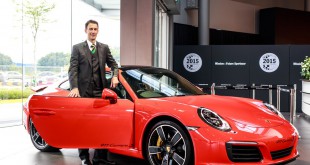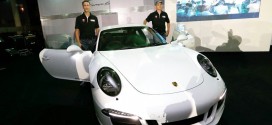Yet from the very first glance it remains unmistakably a Porsche 911. The new Porsche 911 Carrera celebrates its world premiere at the 2011 IAA Frankfurt Motor Show. The launch of the new 911 models gets under way on 3 December 2011, the new cars can be order from 1 Sept 2011. Prices in Germany are 88,038 euro for the 911 Carrera and 102,436 euro for the 911 Carrera S, including 19% VAT and market-specific equipment.
[singlepic id=8221 w=630 h= float=]
The all-new, lightweight body is an intelligent aluminium-steel construction. It is responsible for a significant proportion of the weight reduction of up to 45kgs. The 100mm longer wheelbase and reduced height combined with the up to 20-inch wheels underpin the athletic appearance.
The new 911 Carrera and Carrera S raise the performance and efficiency bar yet another notch. All versions get by with significantly <10 litres of fuel per 100km. Fuel consumption and emissions are up to 16% lower compared with its predecessor. Among other things, this is achieved by systems and functions such as auto start/stop, thermal management, electrical system recuperation, the world’s first 7-speed manual transmission and – in conjunction with the Porsche-Doppelkupplungsgetriebe (PDK) – sailing as it is called. The new electro-mechanical power steering offers not only Porsche’s typical precision and feedback but also helps to increase efficiency and reduce fuel-consumption.
[singlepic id=8214 w=630 h= float=]
The new 911 Carrera with the new 350hp (257kW) 3.4-litre boxer engine and optional PDK consumes a mere 8.2 litres per 100km based on the New European Driving Cycle (NEDC) – 1.6 l/100 km less than its predecessor. Also, at 194 g/km CO2, it is the first Porsche sports car to make it below the 200 g/km mark. With the 911 Carrera S as well, with its 3.8-litre boxer engine and what is now 400hp (294kW), fuel consumption when paired with the optional PDK is reduced by 14% or 1.5 l/100 km (~ 5 mpg imp.) to 8.7 l/100 km despite 15hp (11kW) more power. That equates to CO2 emissions of 205 g/km.
At the same time there are performance improvements in both models. The 911 Carrera S with PDK manages to accelerate from nought to 100km/h in 4.3 seconds. Pressing the Sport Plus button on the optional Sport Chrono package cuts that to 4.1 seconds. The 911 Carrera with PDK needs only 4.6 seconds (Sport Plus 4.4 seconds) to sprint from a standing start to 100 km/h.
[singlepic id=8209 w=630 h= float=]
The new 911 doesn’t just offer better longitudinal dynamics, however, but top performance at an unprecedented level in terms of transverse dynamics as well. In addition to the longer wheelbase, the greater agility, precision and driving stability are based, among other things, on the wider front track, the new rear axle and new electro-mechanical power steering. Depending on the model, there are other standard or optional active control systems available as well that further enhance the driving dynamics. That is especially true for the Porsche Dynamic Chassis Control (PDCC) active roll stabilisation system, available for the first time on the 911 Carrera S. For example, the system reduces lateral inclination when cornering, the tyres always being in the optimal position relative to the road surface and able to transmit higher lateral forces. Maximum cornering speeds are increased as well as faster lap times on racetrack are possible.
We can’t wait to get a closer look at the new 991 generation Porsche 911, but until then, you can now check out the photo gallery after the jump.
Photo Gallery: 2012 Porsche 911 Carrera
[nggallery id=356] FastMotoring Motor News In Speed
FastMotoring Motor News In Speed


